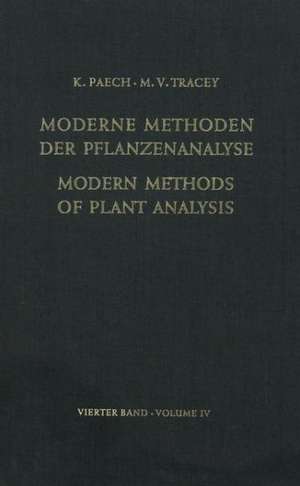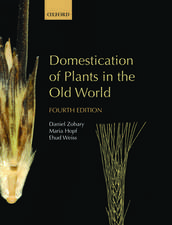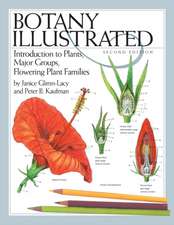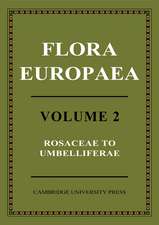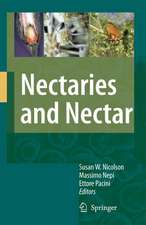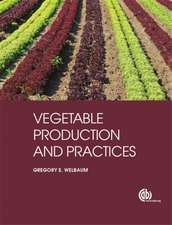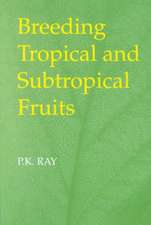Modern Methods of Plant Analysis / Moderne Methoden der Pflanzenanalyse: Volume 4: Modern Methods of Plant Analysis Moderne Methoden der Pflanzenanalyse, cartea 4
Autor K. Paech, M. V. Traceyen Limba Engleză Paperback – 12 feb 2012
| Toate formatele și edițiile | Preț | Express |
|---|---|---|
| Paperback (2) | 425.44 lei 38-44 zile | |
| Springer Berlin, Heidelberg – 12 feb 2012 | 425.44 lei 38-44 zile | |
| Springer Berlin, Heidelberg – 6 dec 2011 | 764.83 lei 38-44 zile |
Preț: 425.44 lei
Nou
Puncte Express: 638
Preț estimativ în valută:
81.42€ • 84.48$ • 68.05£
81.42€ • 84.48$ • 68.05£
Carte tipărită la comandă
Livrare economică 12-18 martie
Preluare comenzi: 021 569.72.76
Specificații
ISBN-13: 9783642649639
ISBN-10: 3642649637
Pagini: 788
Ilustrații: XVI, 766 p.
Dimensiuni: 156 x 244 x 41 mm
Ediția:Softcover reprint of the original 1st ed. 1955
Editura: Springer Berlin, Heidelberg
Colecția Springer
Seria Modern Methods of Plant Analysis Moderne Methoden der Pflanzenanalyse
Locul publicării:Berlin, Heidelberg, Germany
ISBN-10: 3642649637
Pagini: 788
Ilustrații: XVI, 766 p.
Dimensiuni: 156 x 244 x 41 mm
Ediția:Softcover reprint of the original 1st ed. 1955
Editura: Springer Berlin, Heidelberg
Colecția Springer
Seria Modern Methods of Plant Analysis Moderne Methoden der Pflanzenanalyse
Locul publicării:Berlin, Heidelberg, Germany
Public țintă
ResearchCuprins
Inhalteverzeichnis. — Contents..- Peptides (Bound Amino Acids) and Free Amino Acids.- A. Peptides (Bound Amino Acids).- I. Higher Plants.- II. Algae.- III. Fungi.- IV. Glutathione.- V. Pteroic Acid Derivatives etc..- B. Amino Acids.- I. Amino Acids Found in Plants.- II. Determination of Free Amino Acids: General Methods.- III. Special Methods for Free Amino Acids.- IV. Some Results of Analyses for Free Amino Acids in Plant Materials.- References.- Proteins.- A. Methods for Separating Protein from Non-Protein Nitrogenous Material.- B. Methods for Determining Protein.- 1. Determination of Total Dry Matter.- 2. Determination of Nitrogen.- 3. Determination of Amino Acids.- 4. Determination of the Peptide Bond.- 5. Phydcal Methods.- 6. Methods Depending on Specific Activities.- C. The Amino Acid Composition of Tissues and Isolated Proteins.- D. Leaf Proteins.- I. The Normal Mature Leaf.- II. The Proteins of Virus Infected Leaves.- III. The Immature Leaf and Other Young Tissues.- E. Proteinsfrom Miscellaneous Parts of the Plant.- 1. Flowers.- 2. Fruits.- 3. Pollen.- 4. Proteins in Latex.- 5. Proteins in Roots, Tubers and Other Underground Parts of the Plant.- F. Proteins in Algae.- References.- Seed Proteins.- A. Some General Considerations.- I. The Major Seed Proteins.- II. Other Seed Proteins.- 1. Enzymes.- 2. Inhibitors and Toxic Proteins.- III. Amino Acid Composition.- B. Procedures.- I. Choice and Preparation of Initial Material.- II. Extraction.- C. Experimental Procedures for the Preparation of Different Types of Protein Fractions from Seeds.- I. Globulin Fractions.- II. Prolamine from a Cereal Grain.- III. Enzymes, Inhibitors and Toxic Proteins.- References.- Methods of Determining the Nutritive Value of Proteins.- A. Evaluation for Ruminants.- B. Evaluation for Non-Ruminants.- I. Techniques Involving Chemical Analysis, or Microbiological or Enzymatic Assay.- II. Techniques Involving the Use of Animals.- 1. Simple Substitution Technique.- 2. Succesive Substitution Technique, with Nitrogen Balance Trials.- 3. Gross Protein Value.- 4. Biological Value of Protein.- 5. Net Protein Value.- 6. Protein Efficiency Ratio.- 7. Carcase Analysis Technique.- 8. Protein Repletion Techniques.- References.- Urea and Ureides.- A. The Occurence of Urea and its Precursors in Plants.- I. Intermediates in Purine Catabolism.- 1. Uric Acid and Uricase.- 2. Allantoin and Allantoinase.- 3. Allantoic Acid and Allantoicase.- 4. Urea and Urease.- II. Arginine as a Urea Precursor.- III. Canavanine as a Urea Precursor.- IV. Citrulline and Hydantoin.- V. Thiourea.- B. Some Analytical Principles.- I. Uric Acid.- II. Allantoin and Allantoic Acid.- III. Urea.- IV. Arginine, Canavanine, Citrulline and other Compounds.- References.- Chlorophylls: Analysis in Plant Materials.- A. Chlorophylls a and b.- I. Structure and Distribution.- II. Preparation.- III. Physical Properties of Chlorophylls a and b.- IV. Qualitative Test for Chlorophylls a and b.- V. Tests for Purity.- VI. Pheophytins a and b.- VII. Quantitative Determination of Chlorophylls a and b.- B. Chlorophyll c.- I. Preparation of Chlorophyll c.- II. Physical Properties of Chlorophyll c.- III. Qualitative Tests.- IV. Pheophytin c.- V. Quantitative Determination of Chlorophyll c.- C. Chlorophyll d.- I. Preparation of Chlorophyll d.- II. Physical Properties of Chlorophyll d.- III. Qualitative Tests.- IV. Pheophytin d.- V. Quantitative Determination of Chlorophyll d.- D. Chlorophyll e.- E. Protochlorophyll.- I. Preparation of Protochlorophyll.- II. Physical Properties of Protochlorophyll.- III. Analytical Tests.- IV. Protopheophytin.- V. Quantitative Determination of Protochlorophyll.- F. Bacteriochlorophyll.- I. Preparation of Bacteriochlorophyll.- II. Physical Properties of Bacteriochlorophyll.- III. Qualitative Tests.- IV. Bacteriopheophytin.- V. Quantitative Determination of Bacteriochlorophyll.- G. Bacterioviridin.- I. Preparation of Bacterioviridin.- II. Physical Properties of Bacterioviridin.- III.Qualitative Tests.- IV. Bacterioviridin Pheophytin.- H. Special Topics.- I. Preparatory Procedures.- II. Spectrophotometry.- III. Chromatography.- IV. Miscellaneous Procedures.- V. Chlorophyllase.- References.- Haematin Compounds.- A. Spectroscopic Methods.- I. Introduction.- II. Spectroscopes for Analytical Purposes.- III. Apparatus for Comparison Spectroscopy.- IV. Pupillen-Spektroskop.- V. A Comparison of the Microspectroscope and Pupillen-Spektroskop.- VI. The Spectrocolorimeter.- VII. Hartridge Reversion Spectroscope.- VIII. Intensification of Absorption Spectra at Low Temperatures.- IX. Detection of Haematin in Plant Tissues.- X. Estimation of Total Haematin.- B. Cytochromes.- I. Spectral Characteristics.- II. Types of Cytochrome Spectra in Plant Materials.- 1. Cytochromes in Tissues Devoid of Chlorophyll.- 2. Cytochromes in Leaves.- 3. Cytochrome in Marine Algae.- 4. Soluble Cytochrome Components.- III. Quantitative Estimation of Cytochromes.- IV. Cytochrome Oxidase.- C. Haematin Enzymes: Peroxidase and Catalase.- I. Peroxidase.- II. Catalase.- III. Spectroscopy of Peroxidase and Catalase.- D. Root Nodule Haemoglobin.- References.- Nucleic Acids, their Components and Related Compounds.- A. Occurence in Plants.- B. Nucleic Acids: General Structure and Composition.- C. Absorption Spectra.- I. Nucleic Acids.- II. The Smaller Constituents.- D. The Reactions and the Identification of the Purines and Pyrimidines, their Ribosides and Nucleotides.- I. The Purines: General Reactions.- II. The Pyrimidines.- III. The Nucleosides.- IV. The Nucleotides.- E. Paper Chromatography.- I. General Considerations.- II. The Detection of Nucleic Acid Derivatives on Chromatograms.- III. The Separation and Identification of Purines, Pyrimidines and Nucleosides.- F. The Quantitative Analysis of Nucleic Acids for their Bases.- I. Ribonucleic Acids.- II. The Quantitative Analysis of DNA.- G. Separation and Identification of Nucleosides and Nucleotides.- I. Paper Chromatography.- II. Methods for the Identification of the Isomeric Nucleotides.- III. Ion Exchange Chromatography.- IV. The Separation of Nucleic Acid Derivatives by Electrophoresis on Paper.- H. Some Enzymes Used in Nucleic Acid Chemistry.- I. Determination of Phosphate and Carbohydrate.- I. The Analysis of Phosphorus.- II. The Diphenylamine Reaction for Deoxypentose.- III. The Estimation of Pentoses.- J. Other Methods for the Analysis and Determination of Nucleic Acids.- I. Analysis of Ribonucleic Acids by Means of Silver Precipitation.- II. The Recognition of the Nucleic Acids in Tissues by Microscopical Methods.- III. The Estimation of Nucleic Acids in Tissues.- K. The Isolation of Nucleic Acids from Plant Tissues.- I. The Isolation of Deoxyribonucleic Acid from Wheat Germ.- II. Isolation of Ribonucleic Acids from Plant Tissues.- L. Other Purines and Pyrimidines in Plants.- I. Vicine and Divicine.- II. The Methylated Xanthine Derivatives (Caffein and Theobromine).- References.- Adenosine Diphosphate, Adenosine Triphosphate.- A. Occurence and Distribution.- B. Isolation of Adenosine Triphosphate.- I. Difficulties in Isolation.- II. Criteria for Purity.- III. The Isolation of Adenosine Triphosphate from Mung Beans (Phasedus aureus).- C. Determination of Adenosine Triphosphate.- I. Enzymatic Determination.- II. Identification of ATP by Paper Chromatography.- III. The Quantitative Estimation of ATP by Column Chromatography.- D. The Status of Adenosine Diphosphate.- References.- Codehydrasen I und II (Diphospho-pyridin-nucleotid und Triphospho-pyridin-nucleotid).- A. Einleitung.- B. Analytische Verfahren zur Bestimmung der Codehydrasen.- I. Allgemeines.- 1. Der Zustand der Codehydrasen im pflanzlichen Material u. ihre Extraktion.- 2. Bestimmung von Diphospho-pyridin-nucleotid.- 3. Bestimmung von Triphospho-pyridin-nucleotid.- II. Die „Thunberg-Technik“.- III. Manometrische Methoden.- IV. Spektrophotometrische Methoden.- C. Darstellung von Codehydrasen.- 1. Darstellung von Diphospho-pyridin-nucleotid.- 2. Darstellung von Triphospho-pyridin-nucleotid.- 3. Darstellung der Dihydro-codehydrasen.- Literatur.- Thiamine and its Derivatives.- A. Properties of Thiamine Relevant to its Determination.- I. Physical and Chemical Properties.- II. Biological Effects of Thiamine Related to its Determination.- B. Distribution of Thiamine in Plants.- C. Methods for Determination of Thiamine.- I. Extraction of Thiamine from Biological Materials.- II. Biological Methods for the Determination of Thiamine.- III. Enzymatic Methods.- IV. Microbiological Methods.- V. Chemical Methods for the Determination of Thiamine.- 1. The Azo Method.- 2. Thiochrome Method.- 3. Micromethods for Estimation of Thiamine by Thiochrome Method.- VI. Spectrophotometric Estimation of Thiamine.- References.- The Alkaloids.- A. General Introduction.- I. Distribution in the Plant.- II. The Isolation of Alkaloids.- 1. Extraction.- 2. Fractionation.- III. The Quantitative Estimation of Alkaloids.- IV. Reagents.- 1. General Alkaloid Reagents.- 2. Special Reagents.- B. The Alkaloids of Aconitum spp..- I. Properties.- II. Isolation.- III. The Estimation of the Total Alkaloids of Aconite Root.- C. The Alkaloids of Areca Nut.- I. Properties.- II. The Isolation of the Areca Alkaloids.- III. The Detection and Estimation of Arecoline.- D. The Berberis and Hydrastis Alkaloids.- I. Properties.- II. The Distribution of the Alkaloids within the Plant.- III. The Isolation of the Alkaloids.- IV. Qualitative Tests for the Alkaloids.- V. The Quantitative Estimation of Berberine and Hydrastine.- E. The Alkaloids of the Calabar Bean.- I. The Isolation of Physostigmine from Calabar Beans.- II. Methods for the Detection and Estimation of Physostigmine.- F. The Cinchona Alkaloids.- I. Properties.- II. The Distribution of Alkaloids in Cinchona Bark.- III. The Isolation of the Crystallizable Alkaloids.- IV. The Qualitative Reactions of the Cinchona Alkaloids.- V. The Estimation of the Total Alkaloids of Cinchona Bark.- VI.The Determination of the Individual Crystallizable Alkaloids.- G. The Curare Alkaloids.- I. Properties.- II. The Isolation of l-Curine and d-Tubocurarine chloride.- III. Qualitative Reactions of d-Tubocurarine chloride.- IV. The Quantitative Estimation of d-Tubocurarine chloride.- H. The Alkaloids of Ergot.- I. Properties.- II. The Isolation of the Ergot Alkaloids.- III. Detection and Estimation of the Ergot Alkaloids.- I. The Alkaloids of Gelsemium spp..- I. Properties.- II. Isolation of Alkaloids.- III. The Detection and Estimation of the Gelsemium Alkaloids.- J. Alkaloids of Gymnosperms.- I. The Alkaloids of Ephedra spp..- II. Properties.- III. The Isolation of Ephedrine and Pseudoephedrine from Ephedra spp..- IV. Qualitative Tests for Ephedrine.- V. The Quantitative Estimation of Ephedrine.- VI. The Alkaloid of Yew (Taxus baccata L.).- K. The Alkaloids of Hemlock (Conium maculatum L.).- I. Properties.- II. Isolation of the Alkaloids.- III. The Detection and Estimation of the Hemlock Alkaloids.- L. The Alkaloids of Holarrhena spp..- M. The Ipecacuanha Alkaloids.- I. Properties.- II. The Isolation of the Alkaloids.- III. Qualitative Tests for the Ipecacuanha Alkaloids.- IV. The Quantitative Estimation of the Total Alkaloids.- N. The Alkaloids of Liliaceae.- I. The Alkaloids of Colchicum spp..- II. The Veratrum Alkaloids.- O. The Lobelia Alkaloids.- I. Properties.- II. Estimation of Alkaloids in Lobelia Tissues.- P. The Alkaloids of Lolium perenne L. and other Grasses.- Q. The Alkaloids of Opium.- I. Properties.- II. Isolation of the Major Alkaloids from Opium.- III. Qualitative Tests for the Opium Alkaloids.- IV. The Quantitative Estimation of the Opium Alkaloids.- R. The Alkaloids of the Papilionaceae (Lupinane Group).- I. Sparteine.- II. Cytisine.- III. N-Methylcytisine.- IV. Anagyrine.- V. Other Alkaloids.- 1. Calycotomine.- 2. Monspessulanine.- 3. Retamine.- 4. Lupanine.- 5. Lupinine.- 6. Hydroxylupanine.- 7. Virgiline and Virgilidine.- 8. Ammodendrine and Matrine.- S. The Alkaloids of Peganum harmala L..- I. Properties.- II. The Isolation of Harmine and Harmaline.- III. The Detection and Estimation of the Harmala Alkaloids.- T. The Alkaloids of Pilocarpus spp..- I. Isolation of the Alkaloids.- II. Properties.- III. The Detection and Estimation of the Alkaloids of Pilocarpus.- U. The Alkaloids of Pomegranate.- I. Properties.- II. The Isolation of the Alkaloids.- III. The Estimation of the Pomegranate Alkaloids.- V. The Alkaloids of Solanum spp..- I. Properties.- II. The Isolation of Solanine.- III. The Detection and Estimation of the Alkaloids of Solanum.- W. Alkaloids of Strychnos spp..- I. The Isolation of Strychnine and Brucine.- II. Properties.- III. The Detection of Strychnine.- IV. Estimation of Strychnine.- X. The Tobacco Alkaloids.- I. Properties.- II. The Isolation of the Major Alkaloids.- III. The Detection of the Alkaloids of Nicotiana spp..- IV. The Quantitative Estimation of the Alkaloids.- Y. The Tropane Alkaloids.- I. Properties.- II. Isolation of the Tropane Alkaloids.- III. The Detection of the Tropane Alkaloids.- IV. The Quantitative Estimation of Total Alkaloids of Belladonna.- V. The Estimation of the Coca Alkaloids.- Z. The Yohimbe and Quebracho Alkaloids.- I. Properties.- II. The Isolation of Yohimbine.- III. The Detection of the Yohimbe and Quebracho Alkaloids.- IV. The Quantitative Estimation of the Total Alkaloids of Yohimbe Bark.- References.- Amine und Betaine.- A. Allgemeine Verfahren zur Anreicherung und zum Nachweis der Amine.- B. Verfahren zur Isolierung der Amine.- C. Quantitative Bestimmung von Aminen.- D. Nachweis und Identifizierung von Aminen mit Hilfe der Papierchromatographie.- I. Isolierung der Amine aus der Pflanze.- II. Trennung und Nachweis durch Papierchromatographie.- III. Mikrobiologische und pharmakologische Bestimmung von Aminen.- E. Spezieller Teil.- I. Methylamine.- II. Äthanolamine.- III. Cholin.- IV. Acetylcholin.- V. Diamine.- VI. Butyl- und Amylamine.- VII. Amine mit aromatischen Substituenten.- VIII. Histamin.- F. Betaine.- I. Allgemeines.- 1. Mikrochemischer Nachweis der Betaine.- 2. Nachweis der Betaine in Pflanzen.- II. Spezieller Teil.- 1. Betain.- 2. Hypaphorin.- 3. Stachydrin.- 4. Ergothionein.- 5. Hercynin (Histidinbetain).- 6. Betonicin und Turicin.- 7. Trigonellin.- Literatur.- Pantothensäure und Coenzym A.- A. Pantothensäure.- I. Mikrobiologische Bestimmung.- II. Biologische Bestimmung von Pantothensäure mit Hilfe des Wachstumstestes bei Ratten und Küken.- III. Chemische Bestimmung der Pantothensäure.- B. Coenzym A.- 1. Coenzym A-Bestimmung nach Kaplan und Lipmann (1948).- 2. Rasche spektrophotometrische Bestimmung des Coenzyms A nach Korff (1953).- Literatur.- Riboflavin, Folic Acid and Biotin.- A. Riboflavin.- I. Distribution in Plants.- II. Principles of Detection and Estimation.- III. Quantitative Determination of Riboflavin.- 1. Fluorometric Method.- 2. Microbiological Method.- 3. Other Flavins.- B. Pteroylglutamic Acid and Related Compounds.- C. Biotin.- References.- Melanins.- A. Notes on the Isolation and Analysis of Dark Pigments.- B. Some Properties which have been Used in Attempts to Identify Pigments as Melanins.- C. The Detection of Tyrosinase and its Substrates in Plants Producing Presumptive Melanin.- D. Inhibitors and the Possible Nature of Dopa-Oxidase and Tyrosinase.- E. The Infrequent Appearance of Melanins as Secondary Plant Products.- F. Intermediate Stages in Melanogenesis in vitro and Suggestions Concerning the Chemical Structure of Melanins.- References.- Blausäure-Verbindungen.- I. Qualitativer Nachweis von Blausäure.- 1. Freisetzung der Blausäure.- 2. Nachweis-Methoden.- II. Quantitative Methoden.- Literatur.- Senföle, Lauchöle und andere schwefelhaltige Pflauzenstoffe.- A. Einleitung.- B. Schwefel und einfache Schwefelverbindungen.- C. Schwefelsäureester, Sulfonsäuren, Sulfite, Thioäther.- I. Schwefelsäureester.- II. Sulfonsäuren.- III. Thioäther, aliphatische Di- und Polysulfide und Sulfoxyde (Lauchöle).- IV. Die Bestimmung von Alliin.- D. Thioaldehyde.- E. Thioharnstoffe und l-5-Vinyl-2-thiooxazolidon.- F. Senföle und Senfölglykoside.- Literatur.- Sachverzeichnis (deutsch-englisch).- Subject Index (English-German).
